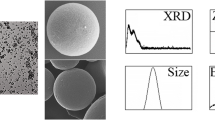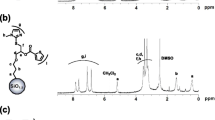Abstract
A series of silsesquioxane nanoparticles containing reactive internal organic functionalities throughout the entire particle body have been synthesized using a surfactant-free method with organosilanes as the sole precursors and a base catalyst. The organic functional groups incorporated are vinyl, allyl, mercapto, cyanoethyl, and cyanopropyl groups. The sizes and morphologies of the particles were characterized using SEM and nitrogen adsorption, while the compositions were confirmed using TGA, FT-IR, solid state NMR, and elemental analysis. The accessibility and reactivity of the functional groups inside the particles were demonstrated by performing bromination and reduction reactions in the interior of the particles.










Similar content being viewed by others
References
Albert K, Bayer EJ (1991) Characterization of bonded phases by solid-state NMR spectroscopy. J Chrom A 544:345–370
Arkhireeva A, Hay JNJ (2003) Synthesis of sub-200 nm silsesquioxane particles using a modified Stöber sol–gel route. Mater Chem 13:3122–3127
Arkhireeva A, Hay JN, Lane JM, Manzano M, Masters H, Oware W, Shaw SJJ (2004) Synthesis of organic-inorganic hybrid particles by sol-gel chemistry. Sol-Gel Sci Technol 31:31–36
Arkhireeva A, Hay JN, Oware WJ (2005) Non-Cryst Solids 351:1688–1695. J Non-Cryst Solids 351:1688–1695
Berthod AJ (1991) Silica: backbone material of liquid chromatographic column packings. J Chrom 549:1–28
Blaaderen A, Vrij A (1992) Synthesis and characterization of colloidal dispersions of fluorescent, monodisperse silica spheres. Langmuir 8:2921–2931
Brozek E, Zharov I (2009) Internal Functionalization and Surface Modification of Vinylsilsesquioxane Nanoparticles. Chem Mater 21:1451–1456
Buguslaw B, Welerowicz T (2004) Stationary phases with special structural properties for high-throughput separation techniques: preparation, characterization and applications. Comb Chem High T Scr 7:291–312
Burns A, Hooisweng O, Wiesner U (2006) Fluorescent core–shell silica nanoparticles: towards “Lab on a Particle” architectures for nanobiotechnology. Chem Soc Rev 35:1028–1042
Dash S, Mishra S, Patel S, Mishra BK (2008) Organically modified silica: synthesis and applications due to its surface interaction with organic molecules. Adv Colloid Interf Sci 140:77–94
Dobryanskaya GI, Zub YL, Barczak M, Dabrowski A (2006) Synthesis and structure-related adsorption characteristics of bifunctional polysiloxane xerogels with methyl and 3-mercaptopropyl groups. Coll J 68:548–557
Fontanals N, Marcé RM, Borrull F (2005) New hydrophilic materials for solid-phase extraction. Trends Anal Chem 24:394–406
Frenkel-Mullerad H, Avnir D (2000) The chemical reactivity of sol− gel materials: hydrobromination of ormosils. Chem Mater 12:3754–3759
Hoffmann F, Cornelius M, Morell J, Fröba M (2006) Silica-based mesoporous organic-inorganic hybrid materials.. Angew Chem Int Ed 45:3216–3251
Jin R-H, Yuan J-J (2005) Simple synthesis of hierarchically structured silicas by poly(ethyleneimine) aggregates preorganized by media modulation. Macromol Chem Phys 206:2160–2170
Jung CY, Kim JS, Kim HY, Ha JM, Kim YH, Koo SMJ (2012) One-pot synthesis and surface modifications of organically modified silica (ORMOSIL) particles having multiple functional groups. Colloid Interface Sci 367:67–73
Kumar R, Roy I, Ohulchanskky TY, Vathy LA, Bergey EJ, Sajjad M, Prasad PN (2010) In vivo biodistribution and clearance studies using multimodal organically modified silica nanoparticles. ACS Nano 4:699–708
Li H, Gui X, Zhang L, Wang S, Ji C, Wei J, Wang K, Zhu H, Wu D, Cao A (2010) Carbon nanotube sponge filters for trapping nanoparticles and dye molecules from water. Chem Commun 46:7966–7968
Loy DA, Gaugher BM, Baugher CR, Schneider DA, Rahimian K (2000) Substituent effects on the sol−gel chemistry of organotrialkoxysilanes. Chem Mat 12:3624–3632
Maciel GE. NMR characterization of functionalized polysiloxanes. In: Solid State NMR of Polymers, Ando I, Asakura T, editors. Amsterdam: Elsevier; 1998. p 923-84.
Nakamura M, Ishimura K (2008) One-pot synthesis and characterization of three kinds of thiol−organosilica nanoparticles. Langmuir 24:5099–5108
Prasannakumaran B, Pavithran C (2010) Bifunctionalized hybrid silica spheres by hydrolytic cocondensation of 3-aminopropyltriethoxysilane and vinyltriethoxysilane. Langmuir 26:730–735
Radu DR, Lai C-Y, Huang J, Shu X, Lin VS-Y (2005) Fine-tuning the degree of organic functionalization of mesoporous silica nanosphere materials via an interfacially designed co-condensation method. Chem Commun:1264–1266
Sing KSW, Everett DH, Haul RAW, Moscou L, Pierotii RA, Rouquérol J, Siemieniewska T (1985) Reporting physisorption data for gas/solid systems with special reference to the determination of surface area and porosity. Pure Appl Chem 57:603–619
Stöber W, Fink A, Bohn E (1968) Controlled growth of monodisperse silica spheres in the micron size range. Colloidal Interface Sci 26:62–69
Takahashi K, Tadanaga K, Hayashi A, Tatsumisago M (2007) Preparation and characterization of polyaminophenylsilsesquioxane particles by two-step acid–base-catalyzed sol–gel process. Chem Lett 36:324–325
Trewyn BG, Giri S, Slowing II, Lin V (2007a) Mesoporous silica nanoparticle based controlled release, drug delivery, and biosensor systems. Chem Commun 3236–3245
Trewyn BG, Slowing II, Giri S, Chen H-T, Lin VS-Y (2007b) Synthesis and functionalization of a mesoporous silica nanoparticle based on the sol–gel process and applications in controlled release. Acc Chem Res 40:846–853
Türker AR (2007) New sorbents for solid-phase extraction for metal enrichment. Clean 35:548–557
Vervoort RJM, Debets AJJ, Claessens HA, Cramers CA, de Jong GJJ (2000) Optimisation and characterisation of silica-based reversed-phase liquid chromatographic systems for the analysis of basic pharmaceuticals. J Chromatogr A 897:1–22
Wan Y, Zhang D, Hao N, Zhao D (2007) Organic groups functionalised mesoporous silicates. Int J Nanotechnol 4:66–99
Wang W, Gu B, Hamilton WJ (2003) Fabrication of two- and three-dimensional silica nanocolloidal particle arrays. J Phys Chem B 107:3400–3404
Yoshitake H (2010) Design of functionalization and structural analysis of organically-modified siliceous oxides with periodic structures for the development of sorbents for hazardous substances. J Mater Chem 20:4537–4550
Zukoski CF, Look J-L, Bogush GH (1994) Formation of uniform precipitates from alkoxides. In: The colloid chemistry of silica, Adv in Chemistry Series 234:451–465
Author information
Authors and Affiliations
Corresponding author
Ethics declarations
This study was funded by the NSF (CHE-1213628) and the NIH (R01ES024681). A portion of this research was performed using EMSL, a DOE Office of Science User Facility sponsored by the Office of Biological and Environmental Research and located at Pacific Northwest National Laboratory Compliance with Ethical Standards.
Conflict of interest
The authors declare that they have no conflict of interest.
Electronic supplementary material
.
ESM 1
(DOCX 338 kb)
Rights and permissions
About this article
Cite this article
Brozek, E.M..., Washton, N.M., Mueller, K.T. et al. Silsesquioxane nanoparticles with reactive internal functional groups. J Nanopart Res 19, 85 (2017). https://doi.org/10.1007/s11051-017-3771-4
Received:
Accepted:
Published:
DOI: https://doi.org/10.1007/s11051-017-3771-4




